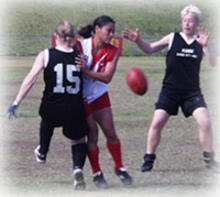You are here
Tackling

Tackling
Tackling must be between the knees and shoulders. To avoid being penalized for a high tackle, go well below the shoulders. Its a good idea anyway to tackle around the waist and to include their arms, to limit the arm movement of your opponent so they find it hard to pass the ball off. For the most, the object of a tackle is to wrap your opponent up, so they can’t pass the ball. Sometimes, though, the nature of the tackle will be to force your opponent to the ground.
When tackling from behind, make sure you bring your opponent directly down or to the side. Umpires are really strict if you tackle from behind and force your opponent down in any forward movement – often known as “in the back”.
Being Tackled
The only time you can be tackled, is, if in possession of the ball. You can be bumped off the ball – but that’s a different action.
Your opponent can tackle you by wrapping their arms around you between your knees and shoulders and therefore limiting your movement. An opponent can also charge at you and knock you to the ground – again providing they tackle you between the knees and shoulders. You only need to be tackled once this way, to realize the importance of not holding onto the ball unless the game situation at that time requires it. Hopefully, your team members around you should be alerting you by telling you ‘you’re hot’ (ie someone is on your tail and you are about to be tackled) or if you have the time to look for your options ie kicking / handballing to a team mate who is free.
Bumping
Bumping is a technique used to push your opponent out of the way while going for the ball. You can only bump a player if 5 metres from the ball – by using your hip, shoulder, chest, arms or open hand. Typically, this is done while you and your opponent are both running for the ball – but can be done in other ways – but you can’t do it when the ball is nowhere near you.


